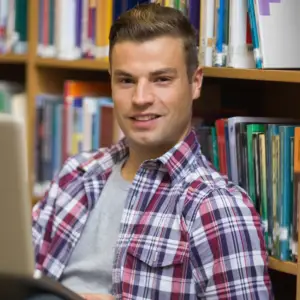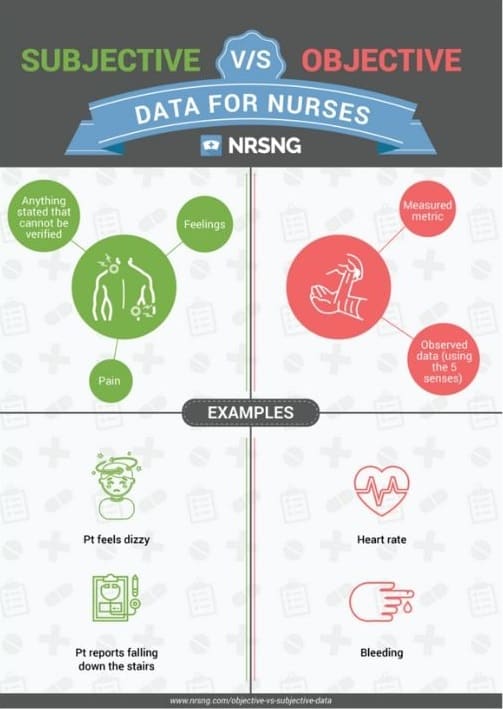How to Understand Subjective vs Objective Data (And Why It Matters!)
If you are a nurse, you know how crucial it is to be able to differentiate subjective data from objective data. Dealing with actual scenarios with a patient would require a ton of quick understanding and efficiency from your part. You must be attentive to information that is provided by a patient and by test results, laboratory values, vitals, and the like.
As you practice in dealing with patients, you would know how vital it is to gather details from a patient, such as how they are feeling or what symptoms they are experiencing.
More than the numbers, this type of information is beyond helpful in order for you to gauge a patient’s current condition. Pay attention to elaborate explanations and, if needed ask clarifying or further questions so your patient would be able to provide more data.
Now, because the difference between the two data–from the patient and from laboratory-based results, can be quite confusing in some instances, we’re here to help you understand them better.
What Is Objective Data in Nursing?
Objective data in nursing is any physical data that can be observed using our five senses. Acquiring this kind of information is done either through direct observation or measurement. The information and results you get from laboratory tests, physical exams, and vitals are plain information and should be treated as objective.
It is a simple concept as it cannot be argued. In this case, what you see is what you get. It is also easy to discern because there is no gray areas, just the information you need. The best example of objective data is weight. Unless the weighing scale is broken, you accept the data provided as correct and accurate.
Here are other examples of objective data that is common in the nursing field:
- Body temperature
- Height
- Heart rate
- Blood pressure
- Level of consciousness
- General appearance
- Respirations
- Level of consciousness
- Wound appearance
- Ambulation description
These details are mostly taken as results of certain health assessments (1) made possible by apparatus like a thermometer and weighing scale. Other objective data can also be taken through direct observation. In order to do so, you have to utilize your sense of smell, hearing, sight, touch, and taste.
The actions of the patient would also tell you a lot of things, especially if these are explicit enough for you to gauge their condition. Do they cry out in pain every time they move? Is the temperature high?
Objective data is mostly based on data collection in the form of observation, interview, health history, physical exam, laboratory and diagnostic testing.
Previous clinical records (2) would also suffice if the patient you are attending to happens to be a patient you already had before.
What is Subjective Data in Nursing?
This is where things usually get harder for nurses. Subjective data is any additional details the patient or their SO gives you that you cannot measure using your five senses. The patient will either provide you the information straight away or you need to ask questions that would lead them to provide you elaborate details of the real situation. In other words, it is the patient’s point of view of his feelings, perceptions, and concerns.
Your patient can tell you information like what symptoms they are experiencing, what concerns they currently have, and how they are feeling. Basically, subjective nursing data is the kind of information that would help you understand the patient’s condition even more.
Remember, our bodies usually respond differently to certain conditions, which is why you don’t have to rely on objective data alone. Subjective data must be gathered properly in order to provide supporting details to the objective data.
An example scenario is when a patient tells you that they have been experiencing ulcer for three days. That scenario they shared with you is subjective finding. There is no other way for you to tell that your patient is suffering from ulcers for that long except for what they reveal.
Moreover, another example of subjective data is pain. There is no apparatus that makes you assess the patient’s pain, especially if they come to you with symptoms of pain. Your instinct would tell you that the pain your patient feels must be addressed as soon as possible although there is no method for you to quantify the amount or level of pain.
Other examples of subjective data are listed below:
- Shortness of breath
- Itching
- Coughing
- Exhaustion
- Dizziness
- Vomiting
Also, when you are confronted with subjective data and you are unsure if it is subjective or objective data, then here’s a go-to question you can ask yourself to simplify your understanding.
- Is this piece of information I can measure or observe using my five senses?
If your answer to that question is no, then treat that kind of information as subjective data.
How to Differentiate Objective Data from Subjective Data?
Understanding objective data and subjective data is quite easy when you read this guide, but it can get tough when you are already in a situation with a patient that gives you both types of data at the same time. If you are a new nurse, then chances are would be, you would get stuck and confused.
Here are some tips on how to understand the differences quickly.
- Signs and symptoms – You must have heard about this phrase many times already. Use it as your guide. Basically, ‘signs’ are considered to be objective data because the signs of the condition can easily be observed or measured.
On the other hand, ‘symptoms’ are considered to be subjective data because the symptoms of a condition are felt by the patient. Therefore, the patient or their companion must tell you and describe what they feel. - ‘Says and observes’ – When you evaluate a situation with both subjective data and objective data, keep in mind that the words ‘subjective’ and ‘says’ begin with the letter S, while the words ‘objective’ and ‘observes’ begin with the letter O. In other words, the patient usually says the subjective data while the nurse (you) observes the objective data.
Here are examples of objective data and subjective data being shown or provided at the same time.
- The patient ‘says’ that he thinks he has a fever and the nurse ‘observes’ the rising temperature on the thermometer.
- The patient ‘says’ his stomach aches as the nurse ‘observes’ the patient clenching his abdomen due to the pain.
- The patient ‘says’ he is shaking tremendously and the nurse ‘observes’ that the patient’s hands are shaking.
- The patient ‘says’ he has a hard time breathing as the nurse ‘observes’ the patient coughs several times.
- The patient ‘says’ he feels dizzy as the nurse observes the patient almost falling down as he tries to grab a seat.
As per the above examples, you will notice how likely frequent it is to happen in real life that the two data match to come up with an initial conclusion for the nurse that indeed, the patient is feeling a certain condition.
However, keep in mind that there are also instances when the objective data and subjective data do not match due to a few reasons. For instance, the patient may tell you about a symptom yet your observations of their actions and expressions tell otherwise.
Are you also familiar with the white coat syndrome? This happens to a healthy patient whose blood pressure suddenly went higher simply because he is nervous in seeing a doctor. That said, you must pay close attention to these possible scenarios too so you don’t get them mixed up.
There are two types of questions when you talk to the patient. The first one is the close-ended question which requires an upfront answer, like asking the age of the patient then getting his age as his response. The other type of question is the open-ended question which explores and identifies problems and concerns.
Why Is It Important to Draw the Line Between Objective and Subjective Data?
Health screening is one of the most crucial aspects of being a nurse. This is the phase when you assess and interview a patient about their condition. Health screening includes the health history of a patient, their current health condition, and risk assessment. More so, it involves the symptoms the patient says to you and the empirical data that can be measured by the five senses or the results you get from laboratory and diagnostic tests.
Knowing how to assess your patient thoroughly by using your understanding of the objective data and subjective data will help you to become efficient in recording and submitting patient records for the doctors to see. Of course, it’s also your duty to be as accurate as possible to whatever goes into the patient’s medical documents.
Finally, understanding objective data vs subjective data will efficiently help you to provide the necessary kind of help or care to your patient that would lead to the improvement of their condition.
Conclusion
We hope that this article has helped you understand the difference of subjective data and objective data. The explanations behind these two types of data are actually simple, but they would most likely come out as challenging for the new nurses who are still getting the hang of everything.
With that said, we always advise for you to take heed of your patient’s current state by listening attentively to their statements and responses. Keep in mind that evaluating the real condition of the patient does not rely solely on numbers, but also on what they feel and recognize with their body.
References
- http://www.delmarlearning.com/companions/content/0766838366/students/ch11/faq.asp
- https://www.rnpedia.com/nursing-notes/fundamentals-in-nursing-notes/assessment-objective-subjective-data/





